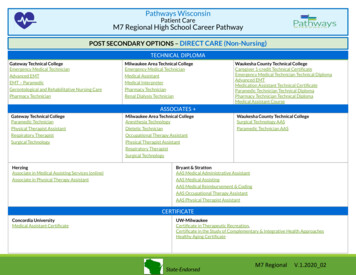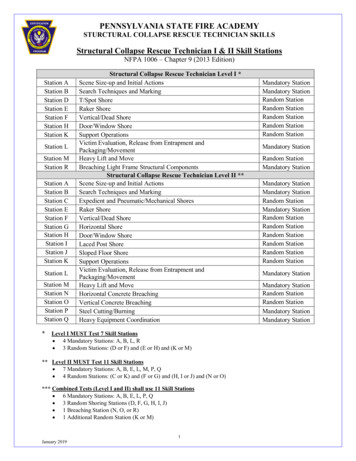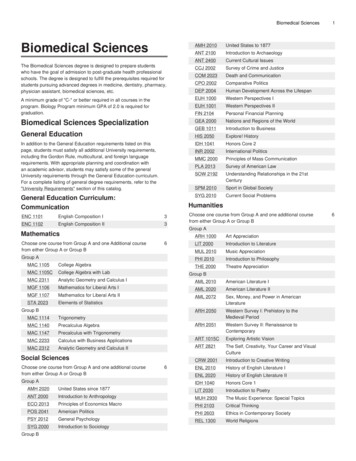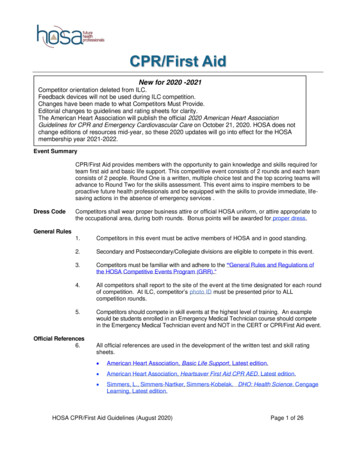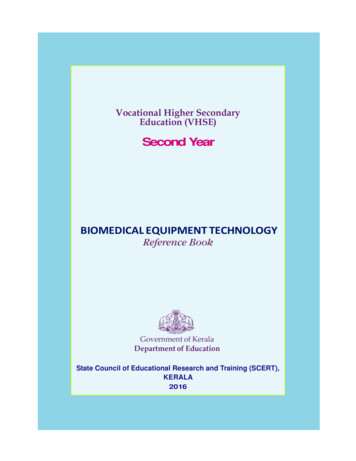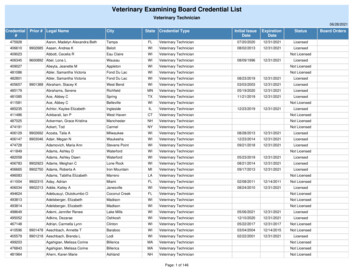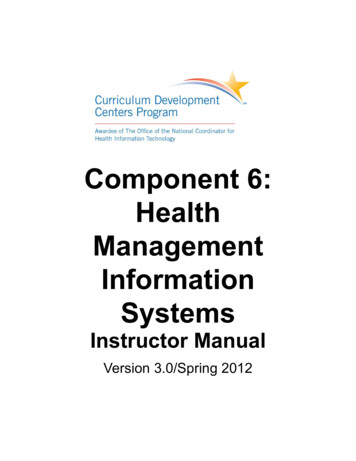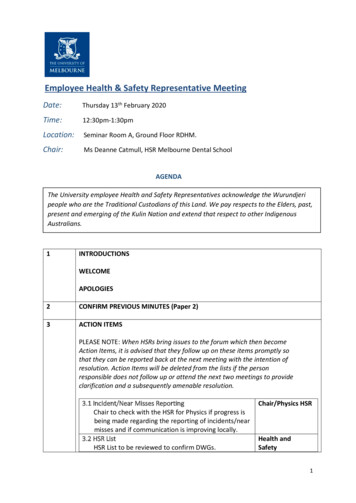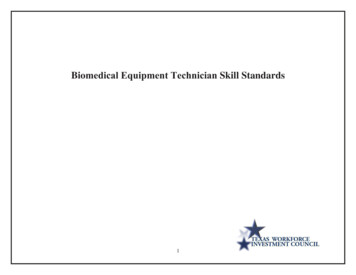
Transcription
Biomedical Equipment Technician Skill Standards1
BIOMEDICAL EQUIPMENT TECHNICIAN SKILL STANDARDSCritical WorkFunctionKey Activity1. Install Biomedical1.1 Receive, inspect andinventory equipment upondelivery1.2 Deliver equipment toinstallation location1.3 Conduct incominginspection1.4 Install equipment2.1 Conduct scheduledpreventive maintenance2.2 Order parts andsupplies2.3 Respond to devicealerts and recalls2.4 Conduct roundsBiomedicalEquipment3.1 Respond to devicefailures reported by users3.2 Diagnose equipmentmalfunctions3.3 Order parts andsupplies3.4 Repair faults andcalibrate equipment4. Follow Safety4.1 Respond toemergencies4.2 Ensure public andemployee safety in thehealthcare facility4.3 Identify hazards in andaround work areasDocumentation5.1 Maintain equipment,parts, and inventorydatabase5.2 Assist with equipmentrecalls and health devicealerts (HDAs)5.3 Update equipmentmaintenancedocumentation6. Schedule andOversee Third PartyRepair6.1 Coordinate resourcesto facilitate repairs6.2 Conduct qualityassurance check of thirdparty repairs6.3 Verify third partydocumentation of repairs7. Provide TechnicalAssistance andInstruction onEquipmentOperation andMaintenance7.1 Demonstrateequipment for facility staff7.2 Respond to userrequests for assistance7.3 Identify need for inservice presentationsEquipment2. Maintain InstalledBiomedicalEquipment3. Repair InstalledProcedures5. ManageKey ActivityKey Activity2Key ActivityKey Activity3.5 Return equipmentto service
BIOMEDICAL EQUIPMENT TECHNICIAN SKILL STANDARDSOccupational Title: Biomedical Equipment TechnicianCritical Work Function 1. Install Biomedical EquipmentKeyActivity1.1 Receive,inspect andinventoryequipmentupon deliveryPerformance CriteriaConditionsHow do we know when the key activity is performedwell or performed successfully?What should the technician know and what skills should thetechnician have in order to do the activity?What tools must the technician use in order todo the activity?1.1.1 Incoming inspection form properlycompletedFunction and operation of monitoring systemsFunction and operation of portable equipmentFunction and operation of life support equipmentFunction and operation of therapeutic equipmentFunction and operation of laboratory equipmentFunction and operation of diagnostic imagingequipmentFunction and operation of electrical safety testequipmentFunction and operation of defibrillator testequipmentFunction and operation of electro-surgical testequipmentFunction and operation of physiologic simulatorsFunction and operation of diagnostic equipmentMedical Device Data Systems (MDDS)Knowledge of electrical safety standards such asNFPA 99Proper lifting techniquesStandard biological precautionsPublic Address alerts and codesHand toolsElectrical safety analyzerComputerized MaintenanceManagement System (CMMS)1.1.2 Incoming inspection form dataaccurately entered into CMMS(Computerized MaintenanceManagement System)1.1.3 Inspection sticker and asset/controlnumber affixed to equipment1.2 Deliverequipment toinstallationlocationOccupational Skills, Knowledge & ConditionsOccupational Skills & Knowledge1.2.1 Work order completion indicates properdelivery1.2.2 Visual inspection by supervisor anddirector3Hand tools
BIOMEDICAL EQUIPMENT TECHNICIAN SKILL STANDARDSOccupational Title: Biomedical Equipment TechnicianCritical Work Function 1. Install Biomedical EquipmentKeyActivity1.3 ConductincominginspectionPerformance CriteriaOccupational Skills, Knowledge & ConditionsOccupational Skills & KnowledgeConditionsHow do we know when the key activity is performedwell or performed successfully?What should the technician know and what skills should thetechnician have in order to do the activity?What tools must the technician use in order todo the activity?1.3.1 Incoming inspection form properlycompletedFunction and operation of monitoring systemsFunction and operation of portable equipmentFunction and operation of life support equipmentFunction and operation of therapeutic equipmentFunction and operation of laboratory equipmentFunction and operation of diagnostic imagingequipmentFunction and operation of electrical safety testequipmentFunction and operation of defibrillator testequipmentFunction and operation of electro-surgical testequipmentFunction and operation of physiologic simulatorsFunction and operation of diagnostic equipmentMedical Device Data Systems (MDDS)Fundamentals of electricity and electronicsKnowledge of electrical safety standards such asNFPA 99Knowledge of ANSI standardsDefibrillator analyzerHand toolsNon-invasive blood pressure (NIBP)analyzerTachometerSpectrum analyzerElectrical safety analyzerElectrical surgical unit (ESU) analyzerPatient simulators (e.g. SpO2 simulator)Frequency scannerFetal monitor simulatorPhantomsO2 meterWatt meterCabling, terminalsTest lungsIV testersPressure metersDiagnostic softwareTest equipmentComputerized MaintenanceManagement System (CMMS)1.3.2 Work order completed in CMMS1.3.3 Completed incoming inspection formattached to work order4
BIOMEDICAL EQUIPMENT TECHNICIAN SKILL STANDARDSOccupational Title: Biomedical Equipment TechnicianCritical Work Function 1. Install Biomedical EquipmentKeyActivity1.4 InstallequipmentPerformance CriteriaOccupational Skills, Knowledge & ConditionsOccupational Skills & KnowledgeConditionsHow do we know when the key activity is performedwell or performed successfully?What should the technician know and what skills should thetechnician have in order to do the activity?What tools must the technician use in order todo the activity?1.4.1 Equipment is configured and performsto users’ requirementsFunction and operation of monitoring systemsFunction and operation of portable equipmentFunction and operation of life support equipmentFunction and operation of therapeutic equipmentFunction and operation of diagnostic imagingequipmentFunction and operation of electrical safety testequipmentFunction and operation of defibrillator testequipmentFunction and operation of electro-surgical testequipmentFunction and operation of physiologic simulatorsFunction and operation of diagnostic equipmentMedical Device Data Systems (MDDS)Network protocolsMedical device integrationFundamentals of electricity and electronicsStandard biological precautionsKnowledge of OSHA standardsKnowledge of electrical safety standards such asNFPA 99Knowledge of ANSI standardsKnowledge of TJC (JCAHO) standardsProper lifting techniquesHand toolsElectrical safety analyzerCabling, terminalsDiagnostic softwareTest equipment1.4.2 Installation work order indicateselectrical safety test passed and meetsNFPA 99 standards1.4.3 Work order indicates performanceverification (functional) test passedsuccessfully1.4.4 Installation is documented in CMMSwith all relevant checklists complete5
BIOMEDICAL EQUIPMENT TECHNICIAN SKILL STANDARDSAcademic and Employability Knowledge and Skill Matrix for Critical Work Function 1: Install Biomedical EquipmentOn a scale of 1 (lowest) to 5 (highest), identify the level of complexity required in each of these skills for the worker to perform the critical workfunction. Keep in mind that this scale is not for rating an individual’s proficiency. It is intended only for rating the level of complexity required to do thework.Occupational Title: Biomedical Equipment TechnicianCWF 1Listening Speaking UsingInformation nizing Using Adaptability Working Leading BuildingSelf andWriting Reading Mathematics ScienceDecisions andSocialinOthers Consensus 333323232Statement of Assessment for Critical Work Function 1:The statements of assessment can do any of several things:Define tools or strategies that industry could use to assess the level of competency a worker has attained in a particular critical work function.Define for trainers and educators how to assess the level of competency a student has attained relevant to the critical work function.Define the level of mastery of the critical work function that indicates that a worker or student has achieved an entry-, intermediate-, oradvanced level of mastery of a critical work function.A. Tests could include:1)Multiple choice and essay questions that demonstrate an understanding of knowledge being assessed.2)Preparation and justification of a reasonable solution to a problem scenario.B. Hands-on exercises or simulations to demonstrate acquisition of knowledge and skills that could:1)Apply relevant knowledge or skills2)Focus on the application of knowledge and skills to a new situation3)Demonstrate an ability to plan, organize, and create a product, service, or an event.4)Illustrate by individual performance the attained levels of knowledge and skills.5)Include observation of events, groups, and individuals that focuses on the relevant traits of the skill in question62
BIOMEDICAL EQUIPMENT TECHNICIAN SKILL STANDARDSOccupational Title: Biomedical Equipment TechnicianCritical Work Function 2. Maintain Installed Biomedical EquipmentKeyActivity2.1 ConductscheduledpreventivemaintenanceOccupational Skills, Knowledge & ConditionsPerformance CriteriaOccupational Skills & KnowledgeConditionsHow do we know when the key activity is performed well orperformed successfully?What should the technician know and what skills shouldthe technician have in order to do the activity?What tools must the technician use in orderto do the activity?2.1.1 Preventive maintenance (PM) work orderindicates electrical safety test passedsuccessfullyFunction and operation of monitoring systemsFunction and operation of portable equipmentFunction and operation of life support equipmentFunction and operation of therapeutic equipmentFunction and operation of laboratory equipmentFunction and operation of diagnostic imagingequipmentFunction and operation of electrical safety testequipmentFunction and operation of defibrillator testequipmentFunction and operation of electro-surgical testequipmentFunction and operation of physiologic simulatorsFunction and operation of oscilloscopesFunction and operation of diagnostic equipmentMedical Device Data Systems (MDDS)Medical device integrationFundamentals of electricity and electronicsFamiliarity with medical terminologyStandard biological precautionsKnowledge of OSHA standardsKnowledge of electrical safety standards such asNFPA 99Knowledge of ANSI standardsKnowledge of TJC (JCAHO) standardsProper lifting techniquesOscilloscopeDefibrillator analyzerHand toolsNon-invasive blood pressure (NIBP)analyzerTachometerSpectrum analyzerElectrical safety analyzerElectrical surgical unit (ESU) analyzerPatient simulators (e.g. SpO2simulator)Frequency scannerFetal monitor simulatorPhantomsElectronic componentsO2 meterWatt meterChemical cleaning suppliesPersonal protective equipment (PPE)Cabling, terminalsTest lungsIV testersIV tubingPressure metersAnti-static matDiagnostic softwarePersonal protective equipmentAudio meterTest equipmentComputerized MaintenanceManagement System (CMMS)2.1.2 PM work order indicates performanceverification (functional) test passed successfully2.1.3 Documentation attached to closed PM workorder indicates equipment operating withinrange of manufacturer specifications2.1.4 PM task is complete within specifieddepartmental time period2.1.5 PM sticker is current and affixed to equipment7
BIOMEDICAL EQUIPMENT TECHNICIAN SKILL STANDARDSOccupational Title: Biomedical Equipment TechnicianCritical Work Function 2. Maintain Installed Biomedical EquipmentKeyActivity2.2 Order partsand suppliesOccupational Skills, Knowledge & ConditionsPerformance CriteriaOccupational Skills & KnowledgeConditionsHow do we know when the key activity is performed well orperformed successfully?What should the technician know and what skills shouldthe technician have in order to do the activity?What tools must the technician use in orderto do the activity?2.2.1 Correct identification of replacement part onorder documentationMedical Device Data Systems (MDDS)Fundamentals of electricity and electronicsFamiliarity with medical terminologyComputerized MaintenanceManagement System (CMMS)Medical Device Data Systems (MDDS)Network protocolsFundamentals of electricity and electronicsFamiliarity with medical terminologyStandard biological precautionsKnowledge of electrical safety standards such asNFPA 99Awareness of Emergency Care Research Institute(ECRI) notificationsMedical Device Data Systems (MDDS)Health Information Portability and AccountabilityAct (HIPAA)Network protocolsFamiliarity with medical terminologyStandard biological precautionsKnowledge of OSHA standardsKnowledge of electrical safety standards such asNFPA 99Knowledge of ANSI standardsKnowledge of TJC (JCAHO) standardsTest equipmentComputerized MaintenanceManagement System (CMMS)2.2.2 Parts ordered from approvedvendor/manufacturer2.2.3 Parts accurately documented in CMMS2.3 Respond todevice alertsand recallsinitiated byvarious entities2.4 Conductrounds2.2.4 Parts ordered with respect to priority of repair2.3.1 Sufficient supply replacements ordered tocomplete device recall2.3.2 Defective or recalled part(s) returned asrequired according to recall instructions2.3.3 Return documentation completed with allrequire data including serial numbers, modelnumbers, etc., according to recall instructions2.4.1 Assigned department is visited as required bysupervisor preference2.4.2 Work Order reflects completion of rounds2.4.3 Favorable technician feedback received duringsupervisor rounds (zone inspection rounds)8Hand toolsPersonal protective equipmentComputerized MaintenanceManagement System (CMMS)
BIOMEDICAL EQUIPMENT TECHNICIAN SKILL STANDARDSAcademic and Employability Knowledge and Skill Matrix for Critical Work Function 2: Maintain Installed Biomedical EquipmentOn a scale of 1 (lowest) to 5 (highest), identify the level of complexity required in each of these skills for the worker to perform the critical workfunction. Keep in mind that this scale is not for rating an individual’s proficiency. It is intended only for rating the level of complexity required to do thework.Occupational Title: Biomedical Equipment TechnicianCWF 2Listening Speaking UsingInformation nizing Using Adaptability Working Leading BuildingSelf andWriting Reading Mathematics ScienceDecisions andSocialinOthers Consensus 333233232Statement of Assessment for Critical Work Function 2:The statements of assessment can do any of several things:Define tools or strategies that industry could use to assess the level of competency a worker has attained in a particular critical work function.Define for trainers and educators how to assess the level of competency a student has attained relevant to the critical work function.Define the level of mastery of the critical work function that indicates that a worker or student has achieved an entry-, intermediate-, oradvanced level of mastery of a critical work function.A. Tests could include:1)Multiple choice and essay questions that demonstrate an understanding of knowledge being assessed.2)Preparation and justification of a reasonable solution to a problem scenario.B. Hands-on exercises or simulations to demonstrate acquisition of knowledge and skills that could:1)Apply relevant knowledge or skills2)Focus on the application of knowledge and skills to a new situation3)Demonstrate an ability to plan, organize, and create a product, service, or an event.4)Illustrate by individual performance the attained levels of knowledge and skills5)Include observation of events, groups, and individuals that focuses on the relevant traits of the skill in question92
BIOMEDICAL EQUIPMENT TECHNICIAN SKILL STANDARDSOccupational Title: Biomedical Equipment TechnicianCritical Work Function 3. Diagnose Equipment MalfunctionsKeyActivity3.1 Respond todevice failuresreported byusersOccupational Skills, Knowledge & ConditionsPerformance CriteriaOccupational Skills & KnowledgeHow do we know when the key activity is performed well orperformed successfully?What should the technician know and what skills shouldthe technician have in order to do the activity?What tools must the technician use inorder to do the activity?3.1.1 Notification from dispatcher is acknowledgedwithin required departmental time framesFunction and operation of monitoring systemsFunction and operation of portable equipmentFunction and operation of life support equipmentFunction and operation of therapeuticequipmentFunction and operation of laboratory equipmentFunction and operation of diagnostic imagingequipmentFunction and operation of electrical safety testequipmentFunction and operation of defibrillator testequipmentFunction and operation of electro-surgical testequipmentFunction and operation of physiologic simulatorsFunction and operation of diagnostic equipmentMedical Device Data Systems (MDDS)Network protocolsMedical device integrationFundamentals of electricity and electronicsFamiliarity with medical terminologyStandard biological precautionsProper lifting techniquesHand toolsElectrical safety analyzerPersonal protective equipment(PPE)Test equipmentComputerized MaintenanceManagement System (CMMS)3.1.2 Technician responds to work order accordingto the assigned priority3.1.3 Technician closes with call initiator todetermine the malfunction symptom3.1.4 Call initiators indicate favorable technicianresponses for example, from customersatisfaction surveys10Conditions
BIOMEDICAL EQUIPMENT TECHNICIAN SKILL STANDARDSOccupational Title: Biomedical Equipment TechnicianCritical Work Function 3. Diagnose Equipment MalfunctionsKeyActivity3.2 DiagnoseequipmentmalfunctionsOccupational Skills, Knowledge & ConditionsPerformance CriteriaOccupational Skills & KnowledgeHow do we know when the key activity is performed well orperformed successfully?What should the technician know and what skills shouldthe technician have in order to do the activity?What tools must the technician use inorder to do the activity?3.2.1 Technician references appropriatemanufacturer service literatureFunction and operation of monitoring systemsFunction and operation of portable equipmentFunction and operation of life support equipmentFunction and operation of therapeuticequipmentFunction and operation of laboratory equipmentFunction and operation of diagnostic imagingequipmentFunction and operation of electrical safety testequipmentFunction and operation of defibrillator testequipmentFunction and operation of electro-surgical testequipmentFunction and operation of physiologic simulatorsFunction and operation of oscilloscopesFunction and operation of diagnostic equipmentMedical Device Data Systems (MDDS)Medical device integrationFundamentals of electricity and electronicsFamiliarity with medical terminologyStandard biological precautionsKnowledge of OSHA standardsKnowledge of electrical safety standards such asNFPA 99Knowledge of ANSI standardsKnowledge of TJC (JCAHO) standardsOscilloscopeDefibrillator analyzerHand toolsNon-invasive blood pressure (NIBP)analyzerTachometerSpectrum analyzerElectrical safety analyzerElectrical surgical unit (ESU)analyzerPatient simulators (e.g. SpO2simulator)Frequency scannerFetal monitor simulatorPhantomsElectronic componentsO2 meterWatt meterPersonal protective equipment(PPE)Cabling, terminalsTest lungsIV testersIV tubingPressure metersAnti-static matDiagnostic softwarePersonal protective equipmentTest equipmentComputerized MaintenanceManagement System (CMMS)3.2.2 Technician exercises efficient use ofavailable, reliable resources, i.e., seniortechnicians, manufacturer technical support,etc.3.2.3 Technician uses appropriate diagnostic toolsto determine the problem11Conditions
BIOMEDICAL EQUIPMENT TECHNICIAN SKILL STANDARDSOccupational Title: Biomedical Equipment TechnicianCritical Work Function 3. Diagnose Equipment MalfunctionsKeyActivity3.3 Order partsand suppliesOccupational Skills, Knowledge & ConditionsPerformance CriteriaOccupational Skills & KnowledgeHow do we know when the key activity is performed well orperformed successfully?What should the technician know and what skills shouldthe technician have in order to do the activity?What tools must the technician use inorder to do the activity?3.3.1 Correct identification of replacement partMedical Device Data Systems (MDDS)Computerized MaintenanceManagement System (CMMS)3.3.2 Parts ordered from approvedvendor/manufacturer3.3.3 Parts accurately documented in CMMS3.3.4 Parts ordered with respect to priority ofrepair12Conditions
BIOMEDICAL EQUIPMENT TECHNICIAN SKILL STANDARDSOccupational Title: Biomedical Equipment TechnicianCritical Work Function 3. Diagnose Equipment MalfunctionsKeyActivity3.4 Repair faultsand calibrateequipmentOccupational Skills, Knowledge & ConditionsPerformance CriteriaOccupational Skills & KnowledgeHow do we know when the key activity is performed well orperformed successfully?What should the technician know and what skills shouldthe technician have in order to do the activity?What tools must the technician use inorder to do the activity?3.4.1 Technician follows procedures from theappropriate manufacturer service manualFunction and operation of monitoring systemsFunction and operation of portable equipmentFunction and operation of life support equipmentFunction and operation of therapeuticequipmentFunction and operation of laboratory equipmentFunction and operation of diagnostic imagingequipmentFunction and operation of electrical safety testequipmentFunction and operation of defibrillator testequipmentFunction and operation of electro-surgical testequipmentFunction and operation of physiologic simulatorsFunction and operation of oscilloscopesFunction and operation of diagnostic equipmentMedical Device Data Systems (MDDS)Medical device integrationFundamentals of electricity and electronicsFamiliarity with medical terminologyStandard biological precautionsKnowledge of electrical safety standards such asNFPA 99Knowledge of ANSI standardsKnowledge of TJC (JCAHO) standardsProper lifting techniquesOscilloscopeDefibrillator analyzerHand toolsNon-invasive blood pressure (NIBP)analyzerTachometerSpectrum analyzerElectrical safety analyzerElectrical surgical unit (ESU)analyzerPatient simulators (e.g. SpO2simulator)Frequency scannerFetal monitor simulatorPhantomsElectronic componentsO2 meterWatt meterChemical cleaning suppliesPersonal protective equipment(PPE)Cabling, terminalsTest lungsIV testersIV tubingPressure metersAnti-static matDiagnostic softwarePersonal protective equipmentAudio meterTest equipmentComputerized MaintenanceManagement System (CMMS)3.4.2 Technician uses appropriate tools tofacilitate repair3.4.3 Performance verification and/or calibrationcomplete to manufacturer specification13Conditions
BIOMEDICAL EQUIPMENT TECHNICIAN SKILL STANDARDSOccupational Title: Biomedical Equipment TechnicianCritical Work Function 3. Diagnose Equipment MalfunctionsKeyActivity3.5 Returnequipment toservicePerformance CriteriaOccupational Skills & KnowledgeHow do we know when the key activity is performed well orperformed successfully?What should the technician know and what skills shouldthe technician have in order to do the activity?What tools must the technician use inorder to do the activity?3.5.1 Final operational check performed permanufacturer specificationMedical Device Data Systems (MDDS)Network protocolsMedical device integrationFamiliarity with medical terminologyStandard biological precautionsKnowledge of electrical safety standards such asNFPA 99Knowledge of TJC (JCAHO) standardsProper lifting techniquesHand toolsPersonal protective equipment(PPE)Computerized MaintenanceManagement System (CMMS)Health Information Portability and AccountabilityAct (HIPAA)Familiarity with medical terminologyStandard biological precautionsKnowledge of OSHA standardsPublic Address alerts and codesAwareness of Emergency Care Research Institute(ECRI) notificationsHand toolsPersonal protective equipment3.5.2 Electrical safety test complete per NFPA 99and/or facility requirements3.5.3 Equipment returned to unit or facility3.5.4 Technician closes with call initiator and/orappropriate leadership3.6 ConductroundsOccupational Skills, Knowledge & Conditions3.5.5 Work Order closed out to include originalcomplaint, technician diagnosis, actual repairof the equipment, and supportingdocumentation3.6.1 Assigned department is visited as requiredby supervisor preference3.6.2 Work Order reflects completion of rounds3.6.3 Favorable technician feedback receivedduring supervisor rounds (zone inspectionrounds)14ConditionsComputerized MaintenanceManagement System (CMMS)
BIOMEDICAL EQUIPMENT TECHNICIAN SKILL STANDARDSAcademic and Employability Knowledge and Skill Matrix for Critical Work Function 3: Repair Installed Biomedical EquipmentOn a scale of 1 (lowest) to 5 (highest), identify the level of complexity required in each of these skills for the worker to perform the critical workfunction. Keep in mind that this scale is not for rating an individual’s proficiency. It is intended only for rating the level of complexity required to do thework.Occupational Title: Biomedical Equipment TechnicianCWF 3Listening Speaking UsingInformation nizing Using Adaptability Working Leading BuildingSelf andWriting Reading Mathematics ScienceDecisions andSocialinOthers Consensus 333233232Statement of Assessment for Critical Work Function 3:The statements of assessment can do any of several things:Define tools or strategies that industry could use to assess the level of competency a worker has attained in a particular critical work function.Define for trainers and educators how to assess the level of competency a student has attained relevant to the critical work function.Define the level of mastery of the critical work function that indicates that a worker or student has achieved an entry-, intermediate-, oradvanced level of mastery of a critical work function.A. Tests could include:1)Multiple choice and essay questions that demonstrate an understanding of knowledge being assessed.2)Preparation and justification of a reasonable solution to a problem scenario.B. Hands-on exercises or simulations to demonstrate acquisition of knowledge and skills that could:1)Apply relevant knowledge or skills2)Focus on the application of knowledge and skills to a new situation3)Demonstrate an ability to plan, organize, and create a product, service, or an event.4)Illustrate by individual performance the attained levels of knowledge and skills5)Include observation of events, groups, and individuals that focuses on the relevant traits of the skill in question152
BIOMEDICAL EQUIPMENT TECHNICIAN SKILL STANDARDSOccupational Title: Biomedical Equipment TechnicianCritical Work Function 4. Follow Safety ProceduresKeyActivity4.1 Respond toemergenciesPerformance CriteriaConditionsWhat should the technician know and what skills shouldthe technician have in order to do the activity?What tools must the technician use in orderto do the activity?4.1.1 Technician responds appropriately tofacility public address alerts and codesHealth Information Portability and AccountabilityAct (HIPAA)Familiarity with medical terminologyStandard biological precautionsKnowledge of OSHA standardsPublic Address alerts and codesAwareness of Emergency Care Research Institute(ECRI) notificationsPersonal protective equipment (PPE)Computerized MaintenanceManagement System (CMMS)Material safety data sheetsSpill kitsHealth Information Portability and AccountabilityAct (HIPAA)Standard biological precautionsKnowledge of OSHA standardsKnowledge of electrical safety standards such asNFPA 99Knowledge of ANSI standardsKnowledge of TJC (JCAHO) standardsPublic Address alerts and codesAwareness of Emergency Care Research Institute(ECRI) notificationsChemical cleaning suppliesPersonal protective equipment (PPE)Diagnostic softwarePersonal protective equipmentComputerized MaintenanceManagement System (CMMS)Material safety data sheetsSpill kitsFundamentals of electricity and electronicsStandard biological precautionsKnowledge of OSHA standardsKnowledge of electrical safety standards such asNFPA 99Knowledge of ANSI standardsKnowledge of TJC (JCAHO) standardsAwareness of Emergency Care Research Institute(ECRI) notificationsPersonal protective equipment (PPE)Computerized MaintenanceManagement System (CMMS)4.1.3 Technician responds appropriately toemergency and disaster drills4.1.4 Technician participates in mandatoryannual safety training and achievessatisfactory scores on both written andperformance assessments4.2.1 Technician wears personal protectiveequipment appropriate for theparticular installation/maintenanceactivity and for the area of the facility4.2.2 Technician works with clinical staff toensure restricted access to areas ofwork as necessary4.2.3 Technician demonstrates respect fordignity and privacy of patients andclients in facility as reflected in patientsatisfaction surveys4.3 Identifyhazards in andaround workareasOccupational Skills & KnowledgeHow do we know when the key activity is performedwell or performed successfully?4.1.2 Technician responds appropriately tointernal and external emergencies4.2 Ensure publicand employeesafety in thehealthcarefacilityOccupational Skills, Knowledge & Conditions4.3.1 Technician sets up barriers asappropriate4.3.2 Technician reports hazards to properpersonnel for remediation4.3.3 Technician ensures proper signageposted in area and, if necessary, reportsto safety committee throughsupervisor.16
BIOMEDICAL EQUIPMENT TECHNICIAN SKILL STANDARDSAcademic and Employability Knowledge and Skill Matrix for Critical Work Function 4: Follo
What should the technician know and what skills should the technician have in order to do the activity? Conditions What tools must the technician use in order to do the activity? 1.3 Conduct incoming inspection 1.3.1 Incoming inspection form properly completed 1.3.2 Work order c
